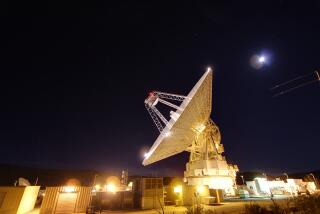NASA Needs a New Mission
As the Cassini space probe dodges through the rings of Saturn and beams back postcards from the far reaches of our solar system, we get an idea of the spectacular goals the U.S. space program is capable of achieving.
Unfortunately, NASA’s efforts closer to its own planet have been much less impressive: a derelict International Space Station and a mothballed space shuttle fleet operating on decades-old technology and performing a near-obsolete mission.
Congress, as it begins debating a newly introduced bill that lays out NASA’s funding priorities for the next four years, should give the space agency more focused directives about its future.
SpaceShipOne, the bullet-shaped plane that last month became the first privately financed manned rocket to make it to the edge of space, and the school-bus-sized Cassini are both good sources of inspiration.
SpaceShipOne, built for $20 million and operated by levers and pulleys not all that different from what the Wright brothers built, shows why entrepreneurs -- gambling that corporations and individuals will pay to get their satellites and selves into space -- are well poised to take over the low-Earth-orbit missions now financed and managed by NASA.
Cassini’s novelty lies not in its economy (at $3.3 billion it’s much pricier than most robot probes) but its management.
It is run by Pasadena’s Jet Propulsion Laboratory, which has been cited as a model of the sort of federally funded research and development center that should replace government-owned facilities such as Johnson Space Center in Houston.
Those bureaucratic descriptors sound indistinguishable, but there is a world of difference.
The government-owned centers are top-down operations, forced to follow rigid federal protocols and civil service hiring, firing and salary rules. The R&D; centers must meet government-dictated goals but have much broader leeway about how to get there.
A presidential advisory commission studying NASA’s future recently recommended emphasizing the R&D; centers while phasing out the government-owned facilities, but it didn’t target any specific center.
Now that NASA’s budget for the next five years is in play, Congress should begin making decisions that the commission dodged.
NASA is still spread too thin. Ideally, Congress should expand funding for challenge grants for entrepreneurs, similar to the privately offered $10-million Ansari X Prize that inspired SpaceShipOne.
It also should fund more science-rich missions such as Cassini with some of the $29 billion the current spending bill squanders on two science-poor missions: the space shuttle and International Space Station.
That’s asking more than Congress is prepared to deliver, but, like the X Prize, it’s a goal to aspire to.
More to Read
Sign up for Essential California
The most important California stories and recommendations in your inbox every morning.
You may occasionally receive promotional content from the Los Angeles Times.










